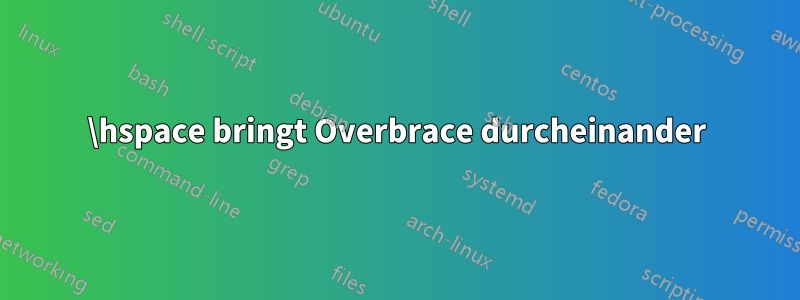
Ich möchte die falsche Überklammerung korrigieren und auch „ADD“ über dem Array platzieren, aber ohne vertikale Trennlinie, vielleicht etwas weiter oben mit einer kleinen Linie, die auf das erste Element des Arrays zeigt. Es tut mir leid, ich bin ein Neuling und verwende Latex zum ersten Mal für einen Unibericht. Das ist mein Code:
\setbox0=\hbox{$
\arrayrulecolor{black} % Color for table borders
\rowcolors{1}{white}{gray!30} % Alternate gray backgrounds in rows
\hspace{-2em}\begin{array}{|c|*{27}{c|}}
ADD \\
\hline
\textbf{128} & \hphantom{0}0 &
\textbf{64} & \hphantom{0}0 &
\textcolor{blue}{\textbf{\hphantom{0}0}} & \hphantom{0}0 &
\textcolor{blue}{\textbf{\hphantom{0}0}}& \hphantom{0}0 &
\textcolor{blue}{\textbf{\hphantom{0}0}} & \hphantom{0}0 &
\textcolor{blue}{\textbf{\hphantom{0}0}} & \hphantom{0}0 &
\textcolor{blue}{\textbf{\hphantom{0}0}} & \hphantom{0}0 &
\textbf{100} & \hphantom{0}0 &
\textbf{1} & \hphantom{0}0 &
\textcolor{blue}{\textbf{0}} & \hphantom{0}0 &
\textbf{5} & \hphantom{0}0 \\
\hline
\end{array}
$}
% Underbrace without left bracket
\[
\overbrace{\usebox0}^{K}
\]
\begin{center}
% Draw a down-facing arrow from "ADD" to the first element
\begin{tikzpicture}
% Downward arrow pointing from "ADD" to the first element
\draw[->, thick] (0, 1.5) -- (0, 0.5); % Draw the down arrow
\end{tikzpicture}
\end{center}
\vspace{-2.5em} % Negative space to bring elements closer
\begin{center}
\[
\arrayrulecolor{black} % Color for table borders
\rowcolors{1}{gray!30}{gray!30} % Alternate gray backgrounds in rows
\hspace{-2em}\begin{array}{|c|*{27}{c|}}
\hline
\hphantom{0}\textbf{128}\hphantom{0} & \textcolor{red}{31} &
\textbf{64}& \textcolor{red}{31}&
\textcolor{blue}{\textbf{64}}& \textcolor{red}{30}&
\textcolor{blue}{\textbf{64}}& \textcolor{red}{29}&
\textcolor{blue}{\textbf{64}}& \textcolor{red}{28}&
\textcolor{blue}{\textbf{64}}& \textcolor{red}{27}&
\textcolor{blue}{\textbf{64}}& \textcolor{red}{26}&
\textbf{100}& \textcolor{red}{31}&
\textbf{1}& \textcolor{red}{31}&
\textcolor{blue}{\textbf{1}}& \textcolor{red}{30}&
\textbf{5}& \textcolor{red}{31} \\
\hline
\end{array}
\]
\end{center}```
Antwort1
Es ist nicht ganz klar, was Sie wollen, aber es könnte so etwas wie das Folgende sein.
- Nur eine
tabularUmgebung - Spalten haben eine feste Breite
- Die Überklammerung erstreckt sich nur über die Spalten nach „ADD“. Da die Spalten eine feste Breite haben, lässt sich ermitteln, wie lang die Überklammerung sein soll.
- Ich habe
\tabcolsepes so angepasst, dass die Tabelle innerhalb der durch festgelegten Ränder liegtgeometry. Abhängig von Ihren Einstellungen können Sie mit dieser Länge experimentieren.
\documentclass{article}
\usepackage[a4paper]{geometry}
\usepackage[table]{xcolor}
\usepackage{array}
\usepackage{amsmath}
\newlength{\lenA}
\newlength{\lenB}
\begin{document}
\begin{center}
\small
\settowidth{\lenA}{ADD}
\settowidth{\lenB}{\textbf{00}}
\setlength{\tabcolsep}{3.7pt}
\begin{tabular}{|w{c}{\lenA}|*{21}{w{c}{\lenB}|}}
\multicolumn{1}{c}{\textrm{ADD}} &
\multicolumn{1}{l}{\makebox[0pt][l]{%
$\overbrace{\hspace{\dimeval{21\lenB+40\tabcolsep+20\arrayrulewidth}}}^K$%
}}
\\
\hline
\rowcolor{gray!30}% Alternate gray backgrounds in rows
\textbf{128} & \hphantom{0}0 &
\textbf{64} & \hphantom{0}0 &
\textcolor{blue}{\textbf{\hphantom{0}0}} & \hphantom{0}0 &
\textcolor{blue}{\textbf{\hphantom{0}0}} & \hphantom{0}0 &
\textcolor{blue}{\textbf{\hphantom{0}0}} & \hphantom{0}0 &
\textcolor{blue}{\textbf{\hphantom{0}0}} & \hphantom{0}0 &
\textcolor{blue}{\textbf{\hphantom{0}0}} & \hphantom{0}0 &
\textbf{100} & \hphantom{0}0 &
\textbf{1} & \hphantom{0}0 &
\textcolor{blue}{\textbf{0}} & \hphantom{0}0 &
\textbf{5} & \hphantom{0}0 \\
\hline
\multicolumn{1}{c}{} \\[-1.5ex]
\multicolumn{1}{c}{$\left\downarrow\vbox to 15pt{}\right.$} \\
\multicolumn{1}{c}{} \\[-1.5ex]
\hline
\rowcolor{gray!30} % Alternate gray backgrounds in rows
\textbf{128} & \textcolor{red}{31} &
\textbf{64}& \textcolor{red}{31}&
\textcolor{blue}{\textbf{64}}& \textcolor{red}{30}&
\textcolor{blue}{\textbf{64}}& \textcolor{red}{29}&
\textcolor{blue}{\textbf{64}}& \textcolor{red}{28}&
\textcolor{blue}{\textbf{64}}& \textcolor{red}{27}&
\textcolor{blue}{\textbf{64}}& \textcolor{red}{26}&
\textbf{100}& \textcolor{red}{31}&
\textbf{1}& \textcolor{red}{31}&
\textcolor{blue}{\textbf{1}}& \textcolor{red}{30}&
\textbf{5}& \textcolor{red}{31} \\
\hline
\end{tabular}
\end{center}
\end{document}



